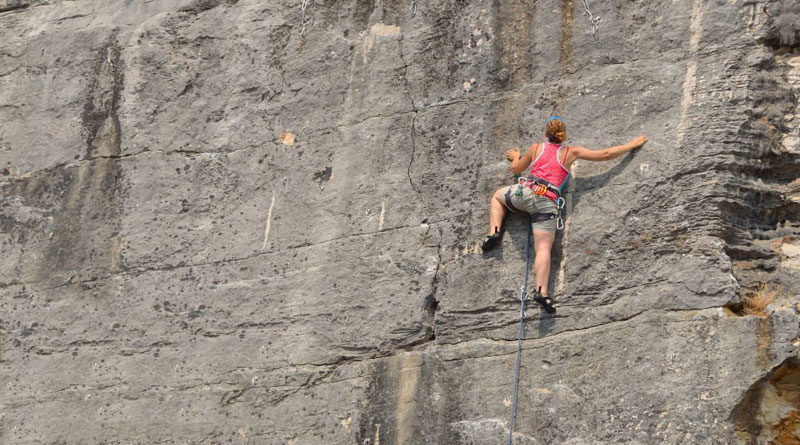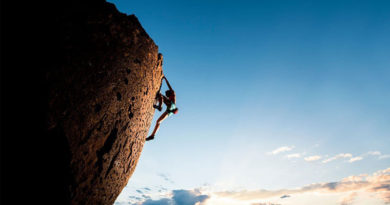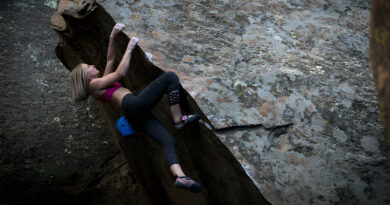Is Rock Climbing Aerobic or Anaerobic?
Rock climbing can involve both aerobic and anaerobic components depending on the type of climbing and the intensity of the activity.
Aerobic exercise is defined as moderately intense, sustained activity that raises the heart rate and breathing rate in order to provide oxygen to the muscles. Aerobic exercise may be involved in rock climbing during long endurance climbs or sustained traversing of a wall. These types of climbing necessarily require sustained activity and can be done at a moderate intensity, which can cause an increase in heart rate and breathing rate.
Anaerobic exercise is defined by high-intensity, short-duration bursts of activity that rely on muscle energy rather than oxygen. Anaerobic exercise may be involved in rock climbing during bouldering or during short, intense climbs that require explosive power and strength.
Aerobic vs. Anaerobic Exercise
To understand the primary energy systems used in rock climbing, it’s important to first distinguish between aerobic and anaerobic exercise. Aerobic exercise is characterized by moderate intensity, sustained activity that increases heart rate and breathing rate to provide oxygen to the muscles. Examples of aerobic exercise include jogging, swimming, and cycling.
Aerobic exercise primarily uses the aerobic energy system, which uses oxygen to generate energy for the muscles. This energy system is highly efficient at producing energy and can sustain moderate activity for extended periods of time. During aerobic exercise, the body uses oxygen to break down glucose and fat molecules, resulting in the production of ATP, the primary fuel source for muscles.
In contrast, anaerobic exercise is characterized by high-intensity, short-duration bursts of activity that typically rely on stored energy in the muscles rather than oxygen. Examples of anaerobic exercise include sprinting, weightlifting, and jumping.
Anaerobic exercise primarily uses the anaerobic energy system, which relies on stored energy in the muscles to produce energy quickly. This energy system is less efficient than the aerobic system but can produce energy rapidly for short bursts of activity. During anaerobic exercise, the body uses stored ATP and creatine phosphate to produce energy for the muscles.
The body uses both aerobic and anaerobic energy systems during exercise, but the relative contribution of each system depends on the intensity and duration of the activity. Low-intensity, sustained activities primarily use the aerobic system, while high-intensity, short-duration activities primarily use the anaerobic system.
The Aerobic Component of Rock Climbing
Rock climbing can have an aerobic component, depending on the type of climbing and the intensity of the activity. Aerobic exercise requires sustained activity at moderate intensity, which elevates heart and breathing rates to provide oxygen to the muscles. The aerobic demands of rock climbing depend on factors such as the length of the climb, the difficulty level, and the pace of the climber.
Climbing long routes or traversing a wall for extended periods requires sustained activity, which can increase heart rate and breathing rate to provide oxygen to the muscles. This type of aerobic climbing can develop muscular endurance, increase cardiovascular fitness, and improve oxygen utilization efficiency.
Rock climbing routes that require sustained activity at moderate intensity include multi-pitch climbing, trad climbing, and endurance climbing. Multi-pitch climbing involves climbing a route that has multiple “pitches” or sections, which can take several hours to complete. Trad climbing involves placing protective gear on the rock to protect against falls, and endurance climbing involves climbing long routes with many difficult moves.
The body responds to aerobic climbing by increasing the flow of oxygenated blood to the working muscles, which helps to deliver the necessary oxygen and nutrients for energy production. To meet the increased oxygen demand, the heart rate and breathing rate increase, and the body releases hormones such as adrenaline and cortisol to support physical exertion. Regular aerobic climbing can improve cardiovascular health, endurance, and overall climbing performance over time.
The Anaerobic Component of Rock Climbing
Rock climbing also has an anaerobic component, which involves high-intensity bursts of activity that rely on stored energy in the muscles rather than oxygen. This type of climbing can develop muscular strength, power, and speed, and is often associated with bouldering, sport climbing, and high-intensity training.
Bouldering is a form of climbing that involves short, intense routes on low-height rocks or artificial walls. This type of climbing requires explosive power and strength to complete challenging moves that often involve dynamic movements such as jumping, leaping, and dynoing. Sport climbing involves climbing routes that are bolted with fixed anchors and requires a combination of strength, endurance, and technical skill to complete.
Rock climbing high-intensity training can include exercises like campus boarding, hangboarding, and power endurance training. Campus boarding requires explosive upper body and finger strength to climb up a series of rungs or holds on a vertical board without using the feet. Hangboarding is the practice of hanging from a small edge or hold to improve grip strength and finger endurance, whereas power endurance training is the practice of climbing routes with many difficult moves to improve muscular endurance and power.
The body uses stored energy in the muscles to produce energy quickly for short bursts of activity during anaerobic climbing. The body relies on anaerobic energy, which is less efficient than aerobic energy but can produce energy quickly. To support physical exertion, the body releases hormones such as adrenaline and cortisol, and lactate accumulates in the muscles as a byproduct of anaerobic metabolism.
Over time, regular anaerobic climbing can improve muscular strength, power, and speed, and enhance overall climbing performance. However, it is important to balance anaerobic training with adequate rest and recovery to prevent injury and overtraining.
Balancing Aerobic and Anaerobic Training
Both aerobic and anaerobic training has unique benefits for rock climbing, and balancing the two types of training is important for overall climbing performance.
Aerobic exercise improves cardiovascular health, endurance, and oxygen utilization efficiency. This type of training is especially beneficial for sustained moderate-intensity climbing activity, which builds muscular endurance and improves cardiovascular fitness. Anaerobic training, on the other hand, increases muscular strength, power, and speed and is especially beneficial for high-intensity bursts of activity that require explosive movements and rapid energy production.
It is critical to balance aerobic and anaerobic training for peak climbing performance. Neglecting one type of training can slow overall progress and increase the likelihood of injury. For example, if a climber only focuses on aerobic training, he or she may improve endurance but lack the strength and power to complete difficult moves. If a climber only focuses on anaerobic training, they may have the strength and power to complete difficult moves but lack the endurance to maintain activity for extended periods of time.
To balance aerobic and anaerobic training, climbers should incorporate a variety of training methods into their routines. This can include long, sustained climbs to develop endurance, as well as high-intensity training such as bouldering, campus boarding, and hangboarding to develop strength, power, and speed. It is also important to prioritize rest and recovery to prevent injury and overtraining.
Conclusion
In conclusion, rock climbing is both an aerobic and anaerobic activity that requires a combination of endurance, strength, power, and speed. Aerobic climbing involves sustained activity at moderate intensity, while anaerobic climbing involves high-intensity bursts of activity that rely on stored energy in the muscles. Balancing aerobic and anaerobic training is essential for optimizing climbing performance, and climbers should incorporate a variety of training methods into their routines and prioritize rest and recovery to prevent injury and overtraining. By balancing these training methods and understanding the demands of rock climbing, climbers can improve their overall performance and reach new heights in their climbing journey.




